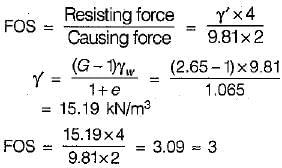Test: Seepage Analysis - 1 - Civil Engineering (CE) MCQ
10 Questions MCQ Test GATE Civil Engineering (CE) 2025 Mock Test Series - Test: Seepage Analysis - 1
From a flow net which of the following information can be obtained?
1. Rate of flow
2. Pore water pressure
3. Exit gradient
4. Permeability
Select the correct answer using the codes given below:
1. Rate of flow
2. Pore water pressure
3. Exit gradient
4. Permeability
Select the correct answer using the codes given below:
Which one of the following soil types is most likely to be subjected to liquefaction under seismic forces?
| 1 Crore+ students have signed up on EduRev. Have you? Download the App |
A flownet of a coffer dam foundation has 6 flow channels and 18 equipotential drops. The head of water lost during seepage is 6 m. If the coefficient of permeability of foundation is 4 x 10-5 m/min, then the seepage loss per metre length of dam will be
Water is flowing in an upward direction through a stratum of sand, 4 m thick, under a total head difference of 2 m. The sand has a specific gr. of 2.65 and void ratio of 0.065. The factor of safety against quick sand condition would be
The constant of proportionality between seepage velocity and hydraulic gradient is called
The critical hydraulic gradient of a soil ic is given by
where G = specific gravity, e = void ratio
If the permeability of soil does not depend on its mineral content but depends on orientation of particles then the void space is known as
|
31 docs|280 tests
|
|
31 docs|280 tests
|

























